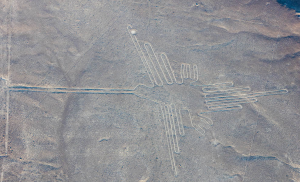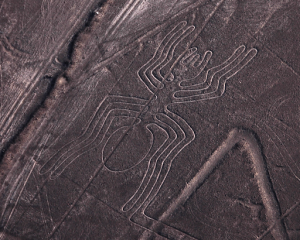Mysteries, Oddities, and Everything Strange: Nazca Lines
October 14, 2022
Nazca Lines: Peruvian Geoglyphs
Hi everyone and welcome back to my column! Because of the new school year, I’m going to change up the structure of my stories a bit. Instead of weird creatures, I’ll be highlighting a strange phenomenon around the world every Friday (or so). Today, this new trend will be kicked off with the mysterious figures that have existed for thousands of years in the deserts of South America: the Nazca Lines.
 These intricately-detailed expanses of sand are just outside of the nation’s capital by about 250 miles. Assigned as a World Heritage Site in 1994 by the United States Educational, Scientific and Cultural Organization, the 80 years of investigation dedicated to the Nazca Lines haven’t unveiled any more significant information than what we have already besides their age at over 2,000 years old. These illustrations are nothing short of gigantic, with the longest individual lines extending more than 30 miles. Their orientation is obviously intentional due to the nature of the illustrations that they create. What exactly are these oddities sprinkled across southern Peru, and what significance do they hold in understanding our own history?
These intricately-detailed expanses of sand are just outside of the nation’s capital by about 250 miles. Assigned as a World Heritage Site in 1994 by the United States Educational, Scientific and Cultural Organization, the 80 years of investigation dedicated to the Nazca Lines haven’t unveiled any more significant information than what we have already besides their age at over 2,000 years old. These illustrations are nothing short of gigantic, with the longest individual lines extending more than 30 miles. Their orientation is obviously intentional due to the nature of the illustrations that they create. What exactly are these oddities sprinkled across southern Peru, and what significance do they hold in understanding our own history?
The first person to actively investigate the history of the lines began in 1926, and his name was Toribio Mejia Xesspe. The lines weren’t a public phenomenon until the popularization of commercial flight, where passengers crossing the 75,000 hectare Rio Grande de Nasca river basin would be able to look down and glimpse them. This worldwide attention led to many other researchers to make discoveries, like American professor Paul Kosok who found that some aligned with the sun during the winter solstice. These people, over the course of nearly a century, attributed these figures to the locals living in the area from 100 BC to 700 AD (the Nazcas, Chavin, and Paracas).
 The designs of the structures vary wildly. They are meant to depict various people, animals, and plants, like monkeys, whales, dogs, flowers, and trees. The lines have all sorts of styles, zig-zagging, waving, or pointing with triangles and squares among other shapes. The lines were made by creating “negative” space through the use of the sand in the desert itself. Interaction with the elements left the surface-exposed sand a dark color, and removing the sand up to about a foot in depth would uncover a much lighter colored, undisturbed sand level.
The designs of the structures vary wildly. They are meant to depict various people, animals, and plants, like monkeys, whales, dogs, flowers, and trees. The lines have all sorts of styles, zig-zagging, waving, or pointing with triangles and squares among other shapes. The lines were made by creating “negative” space through the use of the sand in the desert itself. Interaction with the elements left the surface-exposed sand a dark color, and removing the sand up to about a foot in depth would uncover a much lighter colored, undisturbed sand level.
The real reason why the lines exist might never truly be discovered, but there are plenty of theories floating around that could explain their presence. One of the most supported theories in the investigation is that the figures are meant to indicate the locations of water. The arid climate of the desert does not encourage rainfall, so water would have been a hot commodity, and knowing where exactly to find it would be essential for survival. These lines, however, would not have pointed to oases or acted as a basin, but rather are deliberately structured to allow for rituals. Many of the figures, like spiders, monkeys, and hummingbirds, were symbols of rain and good fertility. Animals were a huge part of Nascan culture and beliefs, so structures like these could simply be offerings to their gods.
 Some more radical theories have been proposed by investigators and anthropologists throughout the years. Aforementioned Paul Kosok happened to investigate the lines the day after the winter solstice in 1941, or the shortest day of the year. While working, he found that the rays of the sun matched up exactly with the layout of the figures, and he drew the conclusion that the two were connected. German Maria Reiche was also very passionate about the lines, and she invested 40 years of her life into investigating them. She was passionate about the idea that they were associated with astronomical patterns and had something to do with the time of year, stating that they were almost like constellations. Some, like Gerald Hawkins in the 60s and 70s, believed that aliens were behind the whole thing because of their aerial perspective.
Some more radical theories have been proposed by investigators and anthropologists throughout the years. Aforementioned Paul Kosok happened to investigate the lines the day after the winter solstice in 1941, or the shortest day of the year. While working, he found that the rays of the sun matched up exactly with the layout of the figures, and he drew the conclusion that the two were connected. German Maria Reiche was also very passionate about the lines, and she invested 40 years of her life into investigating them. She was passionate about the idea that they were associated with astronomical patterns and had something to do with the time of year, stating that they were almost like constellations. Some, like Gerald Hawkins in the 60s and 70s, believed that aliens were behind the whole thing because of their aerial perspective.
Even if the Nazca lines were created for water location, religious worship, or extraterrestrial communication, they are still an essential part of Peruvian culture—but they are facing destruction. The Pan-American highway spanning the stretch of Latin America disrupted rainflow and caused a whole stream to be deposited directly atop one of the hand-shaped figures, eroding it. Oddly enough, an environmental group called Greenpeace was advocating for their conversation but destroyed some in the process. A truck driver traveled over a portion of one of the figures, causing massive damage and scars that cannot be repaired. As with many locations like this, climate change and human activity is threatening them and their historical significance. So, action by people like you and me, even the slightest effort, can help significant attractions remain and be studied further. But for now, the Nazca lines will likely forever remain an unsolvable mystery.
Resources:
https://en.wikipedia.org/wiki/Nazca_Lines
https://www.history.com/topics/south-america/nazca-lines
https://www.nationalgeographic.com/history/article/nasca-lines


















































